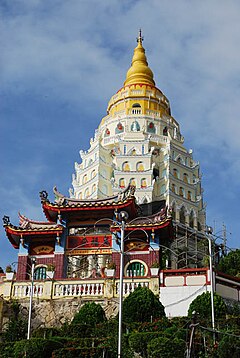Kek Lok Si
| Kek Lok Si Temple 极乐寺 |
|
|---|---|

View of Kek Lok Si Temple
|
|
| Geography | |
| Coordinates | 5°23′58.29″N 100°16′25.43″E / 5.3995250°N 100.2737306°ECoordinates: 5°23′58.29″N 100°16′25.43″E / 5.3995250°N 100.2737306°E |
| Country | Malaysia |
| State | Penang |
| Location | Air Itam |
| Culture | |
| Primary deity | Buddha |
| Architecture | |
| Architectural styles | Chinese, Thai and Burmese |
| History and governance | |
| Date built | 1890-1930 |
| Creator | Beow Lean |
| Kek Lok Si | |||||||||||||
| Traditional Chinese | 極樂寺 | ||||||||||||
|---|---|---|---|---|---|---|---|---|---|---|---|---|---|
| Simplified Chinese | 极乐寺 | ||||||||||||
| Literal meaning | "Temple of Ultimate Happiness" | ||||||||||||
|
|||||||||||||
| Transcriptions | |
|---|---|
| Standard Mandarin | |
| Hanyu Pinyin | Jí lè sī |
| IPA | [tɕǐ lɤ̂ sɨ́] |
| Southern Min | |
| Hokkien POJ | Ki̍k-lo̍k-sī |
The Kek Lok Si Temple (Chinese: 极乐寺; Penang Hokkien for "Temple of Supreme Bliss" or "Temple of Sukhavati" or "Jile Si") is a Buddhist temple situated in Air Itam in Penang facing the sea and commanding an impressive view, and is one of the best known temples on the island. It is said to be the largest Buddhist temple in Malaysia. It is also an important pilgrimage centre for Buddhists from Hong Kong, the Philippines, Singapore and other countries in Southeast Asia. This entire complex of temples was built over a period from 1890 to 1930, an inspirational initiative of Beow Lean, the Abbot. The main draw in the complex is the striking seven-storey Pagoda of Rama VI (Pagoda of Ten Thousand Buddhas) with 10,000 alabaster and bronze statues of Buddha, and the 30.2 metres (99 ft) tall bronze statue of Kuan Yin, the Goddess of Mercy.
Mahayana Buddhism, Theravada Buddhism and traditional Chinese rituals blend into a harmonious whole, both in the temple architecture and artwork as well as in the daily activities of worshippers. The temple is heavily commercialised with shops at every level and inside the main temple complexes selling all religious paraphernalia.
The literal meaning of Kek Lok Si Temple is "Heavenly temple", "Pure Land Temple", "Temple of Supreme Bliss", and the "Temple of Paradise".
The construction of the temple began in 1890 and completed in 1905. It was inspired by Beow Lean, the chief monk of the Goddess of Mercy Temple at Pitt Street in 1887; he had served earlier in the Kushan Abbey in Fujian in China. The site chosen by Beow, a spiritual location in the hills of Ayer Itam, facing the sea, was named "Crane Mountain". It was established as a branch of the Buddhist Vatican in Drum Mountain in Foochow in Hokkien province. Beow Lean was the first Abbot of the temple. The buildings of the temple complex were sponsored by five leading Chinese business people of Penang known as "Hakka tycoons". They were: Cheong Fatt Tze, his cousin Chang Yu Nan, Chea Choon Seng, Tye Kee Yoon, and Chung Keng Kooi. Collection of funds for building the temple was also facilitated by dedicating the structures and artefacts in the name of the temple's benefactors. The main hall, which was completed first, housed a shrine to Guanyin, in a recessed area where many other female goddesses called the Queen of Heaven, the Goddess of the Earth, and Goddess of Childbirth are housed; which is said to represent, on a miniature scale, the island of Potalaka where there is a large shrine dedicated to Guanyin in the China Sea. People compared this shrine to the Amitabha Buddha's Western Paradise and started calling it the "Kek Lok Si" ("Jile Si"). There are also many other shrine chambers, which have stately statues, all gilded, of the Buddhas, Bodhisattvas, saintly Lohans, guardian spirits, and Heavenly (or Diamond) Kings of Pure Land Buddhism.
...
Wikipedia

